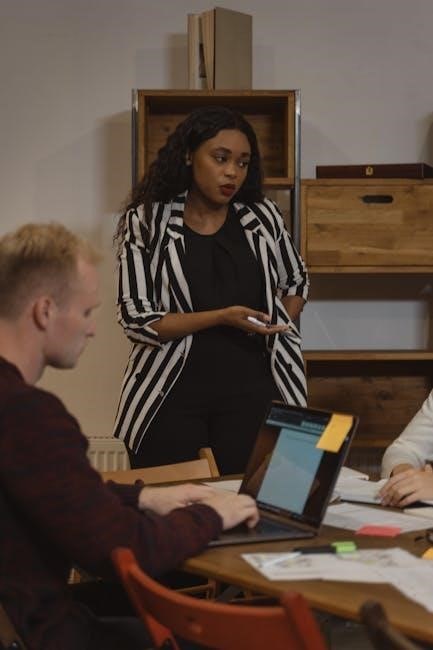Discover the art of effective communication with Leil Lowndes’ “How to Talk to Anyone,” offering 92 practical tips to enhance your interpersonal skills and relationships.
Overview of the Book
Leil Lowndes’ “How to Talk to Anyone” offers 92 practical tips to improve communication skills, helping readers build confidence and foster meaningful relationships. Published in 2003, the book provides actionable advice on navigating social and professional interactions with ease. From mastering small talk to understanding non-verbal cues, Lowndes’ techniques are designed to transform anyone into a compelling conversationalist. The book is widely available in PDF format, making it accessible for readers worldwide to enhance their interpersonal abilities and achieve personal and professional success;
Importance of Effective Communication
Effective communication is the cornerstone of building strong relationships and achieving personal and professional success. It fosters understanding, reduces misunderstandings, and strengthens connections. In “How to Talk to Anyone,” Leil Lowndes emphasizes the transformative power of clear and confident communication. By mastering these skills, individuals can navigate social and professional interactions with ease, fostering trust and collaboration. The book provides practical insights, making it an invaluable resource for anyone seeking to enhance their communication abilities and improve their overall quality of life.

Key Concepts in Effective Communication
Effective communication is the foundation of meaningful interactions. It involves clarity, active listening, and understanding non-verbal cues. Confidence and adaptability are essential for fostering connections and ensuring messages are conveyed clearly and respectfully.
Building Confidence in Conversations
Building confidence in conversations is essential for effective communication. Techniques like maintaining eye contact, preparing topics in advance, and focusing on others’ strengths can boost self-assurance. Practicing active listening and using positive body language helps create a welcoming atmosphere. Confidence grows with experience, allowing individuals to express themselves authentically and engage meaningfully. Leil Lowndes’ tips emphasize the importance of mindset and preparation to overcome nervousness and foster connections.
The Power of Active Listening
Active listening is a cornerstone of effective communication, emphasizing genuine engagement with others. Techniques like “Sticky Eyes” encourage sustained eye contact, while paraphrasing and open-ended questions foster deeper connections. This approach not only enhances understanding but also builds trust and rapport. By focusing on the speaker’s message without interruption, active listening demonstrates respect and fosters meaningful dialogue, making conversations more productive and fulfilling for all parties involved.
Understanding Non-Verbal Cues
Non-verbal cues, such as body language and facial expressions, play a crucial role in communication. Techniques like “Sticky Eyes” emphasize maintaining eye contact to show genuine interest. Mirroring the other person’s gestures fosters rapport, while controlling personal space and posture conveys confidence. These subtle actions often speak louder than words, influencing how messages are perceived. Mastering non-verbal communication enhances overall interactions, as it aligns your physical presence with your verbal message, creating a more cohesive and impactful conversation.

Advanced Communication Techniques
Explore advanced strategies like mirroring, active listening, and subtle non-verbal cues to deepen connections and navigate complex conversations with ease and confidence.
Adapting to Different Personalities
Mastering the art of connecting with diverse personalities is crucial for effective communication. Leil Lowndes’ book provides 92 tips to help you adapt your approach, ensuring meaningful interactions. By understanding individual traits, you can mirror behaviors, adjust your tone, and tailor your messaging. These strategies foster empathy and build rapport, making conversations more engaging and productive. Whether dealing with introverts or extroverts, these techniques empower you to navigate any social dynamic with confidence and grace, ensuring you leave a lasting impression.
The Art of Storytelling in Conversations
Storytelling is a powerful tool for captiviting others and building emotional connections. Leil Lowndes’ book emphasizes the importance of sharing personal anecdotes and experiences to make conversations more engaging. By weaving stories naturally into dialogue, you can create memorable moments and foster deeper relationships. The key is to keep tales authentic, relatable, and relevant to your audience. Mastering this skill transforms you into a compelling and memorable conversationalist, leaving a lasting impression on everyone you meet. Storytelling is not just about entertainment—it’s about connection and understanding.

Specific Tips for Common Communication Scenarios
Learn practical advice for navigating everyday conversations, from starting discussions with strangers to handling tricky interactions, ensuring smooth and meaningful communication in any situation.
Starting a Conversation with Strangers
Starting conversations with strangers can feel daunting, but the book offers practical tips to make it effortless. Use the “Sticky Eyes” technique to maintain confident eye contact, showing genuine interest. Smile warmly and approach with an open posture to create a welcoming atmosphere. Find common ground by commenting on your surroundings or current events. Ask open-ended questions to encourage meaningful dialogue and avoid one-word answers. Remember, the goal is to be authentic and engaging, not perfect. Practice these strategies to build confidence in initiating conversations anywhere, anytime. The book provides actionable advice to help you connect with anyone, no matter the setting.
Handling Difficult or Awkward Interactions
Difficult conversations can be challenging, but the book provides strategies to navigate them smoothly. Stay calm and composed, using the “Great Scorecard in the Sky” technique to avoid taking things personally. Maintain eye contact with “Sticky Eyes” to show confidence and sincerity. Redirect the conversation positively by acknowledging the other person’s perspective and steering toward a resolution. Use humor or a light-hearted comment to ease tension. Practice active listening to understand their viewpoint and respond thoughtfully. These tips help turn awkward moments into opportunities for connection and understanding.

Overcoming Communication Barriers
Overcoming communication barriers requires active listening, empathy, and adapting your style to others’ needs. These techniques help bridge gaps and foster understanding in any interaction.
Managing Anxiety in Social Situations
Managing anxiety in social situations is crucial for effective communication. Leil Lowndes’ tips include deep breathing exercises, positive self-talk, and gradual exposure to social environments. These techniques help reduce nervousness and build confidence, allowing individuals to engage more comfortably. By addressing physical symptoms and mental barriers, individuals can overcome anxiety and improve their ability to connect with others in various settings. These strategies are essential for fostering meaningful relationships and professional success.
Bridging Cultural Communication Gaps
Bridging cultural communication gaps is essential for effective interaction in diverse settings; Leil Lowndes’ “92 Tips to Talk to Anyone” offers insights into understanding cultural differences and adapting communication styles. By researching cultural norms, being attentive to non-verbal cues, and showing genuine interest, individuals can foster mutual understanding. Empathy and adaptability are key to overcoming language and cultural barriers, enabling meaningful connections across diverse backgrounds. These strategies help build rapport and ensure clear communication in global interactions.

The Role of Empathy in Communication
Empathy is crucial in building meaningful connections, allowing individuals to understand and share others’ perspectives. It fosters trust and deepens relationships, making communication more effective and genuine.
Understanding and Sharing Perspectives
Understanding and sharing perspectives is vital for meaningful connections. Active listening and empathy allow you to grasp others’ viewpoints, while clear expression of your own ensures mutual comprehension. Techniques like mirroring and open-ended questions foster deeper understanding, helping to bridge gaps and build rapport. By valuing diverse opinions, you create an environment of trust and collaboration, enhancing communication and relationships. This approach, emphasized in “92 Tips to Talk to Anyone,” highlights the importance of empathy and mutual understanding in effective dialogue.
Developing Emotional Intelligence
Emotional intelligence is crucial for effective communication, enabling you to recognize and manage your emotions and those of others. It fosters empathy, allowing you to connect deeply with people. Techniques like self-awareness and empathy help you navigate interactions smoothly. By understanding emotional cues, you can adapt your approach to build stronger relationships. The book provides practical tips to enhance emotional intelligence, such as maintaining eye contact and using open-ended questions, ensuring meaningful and impactful conversations.
Developing emotional intelligence improves communication by helping you stay attuned to others’ needs and feelings, fostering trust and collaboration. This skill is vital for personal and professional success.
Mastery of Small Talk
Mastering small talk involves techniques like “Sticky Eyes” to maintain engaging eye contact, ensuring conversations flow naturally and leave a lasting impression on others.
Techniques for Engaging Small Talk
Mastering small talk requires techniques like “Sticky Eyes,” where you maintain warm, engaging eye contact, and using open-ended questions to spark meaningful conversations.
These methods help create a comfortable atmosphere, making interactions more enjoyable and memorable; By showing genuine interest and adapting your approach, you can turn casual chats into lasting connections, ensuring others feel valued and heard in every exchange.

Networking and Professional Communication
Effective communication in networking events involves active listening, maintaining eye contact, and asking open-ended questions to build connections and establish rapport with professionals.
Effective Communication in Networking Events
Effective communication in networking events is crucial for building professional relationships. Techniques like maintaining eye contact, using open-ended questions, and active listening can foster meaningful connections. Leil Lowndes’ “92 Tips” emphasizes the importance of adapting communication styles to different personalities. Strategies such as the “Big-Baby Pivot” help navigate conversations smoothly. Listening more than speaking and showing genuine interest in others’ work can make interactions more engaging. These tips enable professionals to leave a lasting impression and expand their network effectively in any setting.

Handling Different Social Situations
Mastering diverse social scenarios requires adaptability and confidence. Techniques like “Sticky Eyes” and the “Big-Baby Pivot” help navigate interactions smoothly, ensuring engaging and memorable conversations in any setting.
Communicating at Parties and Social Gatherings
Mastering communication at parties and social gatherings is key to building connections. Use techniques like “Sticky Eyes” to maintain engaging eye contact and the “Big-Baby Pivot” to seamlessly shift conversations. These strategies help you navigate diverse social dynamics with confidence, ensuring meaningful interactions and leaving a lasting impression in any setting.
Mastering Communication in Networking Events
Networking events require strategic communication to build professional relationships. Use techniques like “The Great Scorecard in the Sky” to make others feel important and “Sticky Eyes” to maintain engaging eye contact. These strategies help navigate networking dynamics, ensuring meaningful conversations and lasting connections. By applying these tips, you can confidently interact with diverse personalities, fostering collaboration and opportunities in any professional setting.
Effective Online Communication
Adapting communication skills for online interactions is crucial in today’s digital world. Use techniques like clarity and brevity to ensure your message is understood. Apply “Sticky Eyes” by maintaining focus on the conversation, even without physical presence. Incorporate tone markers or emojis to convey emotions effectively. Practice active engagement through timely responses and thoughtful questions. These strategies help bridge gaps in online communication, fostering meaningful connections and ensuring your voice is heard in virtual spaces. Mastering these tips enhances your ability to communicate confidently online.

Continuous Improvement in Communication Skills
Regularly practicing and refining techniques from “92 Tips to Talk to Anyone” helps enhance your ability to connect effectively. Focus on understanding perspectives and adapting communication styles for better interactions. Keep improving by applying these strategies in daily conversations to build stronger relationships and achieve personal and professional success. Consistent effort leads to mastery in communication, making it a lifelong skill. Stay committed to growth and refinement for lasting results.
Practicing and Refining Communication Techniques
Mastering communication requires consistent practice and refinement. Start by applying one tip at a time, such as active listening or adapting your style to others. Set daily goals to engage in meaningful conversations and reflect on what worked well. Seek feedback from trusted individuals to identify areas for improvement. Regularly revisit the 92 tips to reinforce learning and adapt them to various social scenarios. Over time, these techniques will become second nature, enhancing your ability to connect with anyone effectively and confidently.
The Impact of Technology on Communication
Technology has transformed how we communicate, emphasizing the need to adapt traditional techniques to digital platforms like video calls and social media, ensuring clarity and connection remain intact.
Adapting Communication Skills in the Digital Age
The rise of technology has reshaped communication, emphasizing the need to adapt traditional interpersonal skills to digital platforms. Video calls, social media, and messaging apps require new strategies to convey clarity and empathy. Techniques like active listening and non-verbal cues must be translated into digital contexts, such as optimizing video call settings and crafting clear, concise messages. The book highlights the importance of maintaining authenticity and connection in virtual interactions, ensuring effective communication despite physical distance. Adapting these skills is crucial for fostering meaningful relationships in the digital world.
Mastering communication transforms relationships and opportunities. Leil Lowndes’ 92 tips offer practical wisdom to enhance your interactions, fostering confidence and genuine connections in all aspects of life.
Summarizing Key Takeaways
“How to Talk to Anyone” by Leil Lowndes provides 92 actionable tips to improve communication skills. The book emphasizes building confidence, active listening, and understanding non-verbal cues. It offers practical advice for various social scenarios, from starting conversations with strangers to handling difficult interactions. Techniques like “sticky eyes” for maintaining eye contact and adapting to different personalities are highlighted. The guide also bridges cultural gaps and underscores the importance of empathy and emotional intelligence. These strategies help readers become more effective and confident communicators in both personal and professional settings, making it a valuable resource for anyone seeking to enhance their social interactions and relationships.
Next Steps for Improving Communication Skills
Practicing the 92 tips from Leil Lowndes’ book is essential for refining communication skills. Start by implementing one technique daily, such as maintaining eye contact or active listening. Engage in conversations with diverse personalities to adapt your approach. Reflect on interactions to identify strengths and areas for improvement. Seek feedback from trusted individuals and incorporate it into your communication style. Consistent practice and self-awareness will enhance your ability to connect effectively with others in both personal and professional settings.

Additional Resources for Further Learning
Download the “How to Talk to Anyone” PDF for 92 practical tips. Explore online courses and workshops for advanced communication techniques and continuous skill improvement.
Recommended Books and Articles
For further learning, download “How to Talk to Anyone” by Leil Lowndes, offering 92 practical tips for effective communication. Explore additional resources like “The Art of Conversation” and articles on emotional intelligence. Visit platforms such as Project Gutenberg or Academia.edu for free eBooks and scholarly articles. These materials provide insights into advanced communication techniques, helping you refine your skills and build stronger relationships.
Online Courses and Workshops
Enhance your communication skills with online courses and workshops available on platforms like Coursera and Udemy. These resources offer practical lessons on effective dialogue, body language, and emotional intelligence. Additionally, websites like Academia.edu provide access to workshops and discussions on improving interpersonal interactions. For a deeper dive, explore courses like “The Art of Communication” or “Mastering Small Talk,” which align with the principles outlined in “92 Tips to Talk to Anyone.”
These online resources are ideal for refining your conversational abilities and applying the strategies discussed in Leil Lowndes’ book. Many courses are free or low-cost, making them accessible for continuous learning and skill improvement.
